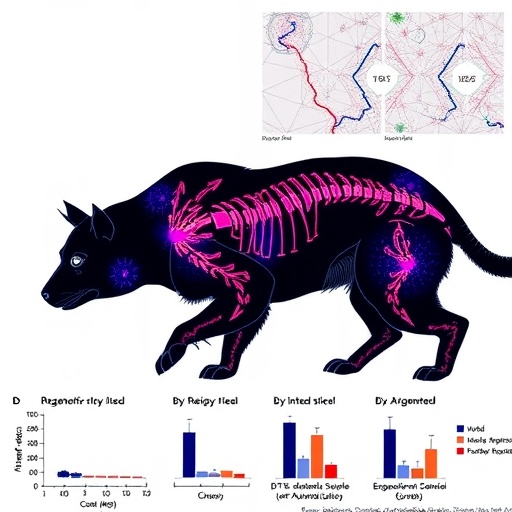Tissue regeneration has captivated scientists for centuries, luring researchers into its intricate web of cellular mechanisms and biochemical pathways. The regenerative capacities of various organisms, from axolotls that regrow limbs to the unfathomable resilience of certain amphibians, offer tantalizing glimpses into the future of regenerative medicine. With advancements in technology, researchers are beginning to decipher the complex crosstalk between different signaling pathways that govern regeneration. As we explore this burgeoning field, the understanding of regeneration will likely redefine therapeutic approaches to injuries, degenerative diseases, and aging.
In recent years, research has shifted towards understanding the duration and location of signaling events within tissues. Chromatin structure plays a crucial role in how genes are expressed, influencing cellular behavior in regenerative contexts. Enhancer regulation has emerged as a key player in these processes, as these regulatory sequences can manipulate gene expression in a spatially and temporally precise manner. By investigating how enhancers interact with transcription factors and other proteins, scientists are uncovering new regulatory networks that can be manipulated to enhance regenerative processes.
Immune cells have long been recognized as essential players in tissue regeneration. The immune response, which was previously viewed primarily as a disturbance during healing, is increasingly understood as a finely tuned orchestrator of regeneration. The interplay between immune cells and regenerative cues—like growth factors released from damaged tissues—affects how tissues respond to injury. Understanding this immune-tissue crosstalk is critical for developing therapies that harness the body’s own defense mechanisms to promote effective healing.
Additionally, bioelectric signals, which represent the electrical activity of cells, are proving to be fundamental in tissue regeneration. Recent studies suggest that bioelectric cues can modulate cellular behavior and are integral to cellular communication during wound healing and regeneration. For instance, the manipulation of membrane potential can trigger cellular responses that are crucial for tissue growth and repair. Insights into the ways that bioelectric signals interact with biochemical pathways open exciting new avenues for regenerative medicine, allowing for innovative therapeutic strategies that leverage these electrical properties.
Metabolic cues also play a crucial role in regeneration. Cellular metabolism can significantly influence cellular identity and function, determining whether a cell will proliferate, differentiate, or remain quiescent during the regeneration process. Recent research is shedding light on how shifts in metabolic state, often initiated by injury, can provide the necessary energy and substrates for reparative processes. By understanding how metabolic pathways can be synchronized with regeneration-enhancing signals, scientists are laying the groundwork for new treatments that may improve healing times and outcomes.
Quantitative modeling provides another layer of depth to our understanding of tissue regeneration. By employing mathematical modeling techniques, researchers can simulate and predict cellular behavior during the regenerative process. These models help quantify the temporal dynamics of signaling pathways and can delineate how different factors contribute to tissue repair. In this way, quantitative modeling is not merely a tool for analysis but serves as a bridge linking basic research to clinical applications, allowing for more targeted and effective therapeutic strategies.
The advent of cutting-edge technologies is revolutionizing our understanding of regeneration at both the cellular and organismal levels. Techniques such as single-cell sequencing, advanced imaging methods, and robust in vivo tracking allow scientists to visualize the regeneration process in real time. These tools provide unprecedented insights into cellular diversity and the orchestration of collective responses during regeneration, showcasing the dynamics of cellular interactions that were previously hidden in bulk analyses.
Recent studies employing these technologies have revealed that cellular heterogeneity plays a vital role in how tissues regenerate. Different cell types, characterized by distinct transcriptional patterns and functional capacities, contribute to a robust repair process. By investigating the roles of various cellular subsets, researchers can begin to understand the intricacies that underpin effective tissue repair and identify potential cellular targets for therapeutic interventions.
As our knowledge of regeneration continues to evolve, future research directions will likely focus on harnessing this information to develop therapies that stimulate or enhance the body’s inherent regenerative abilities. Efforts to manipulate signaling pathways actively are particularly promising. By selectively modulating key factors involved in regeneration, scientists aim to enhance the body’s repair mechanisms, potentially leading to breakthroughs in treating conditions that currently have limited regenerative capacity.
Furthermore, as models become increasingly refined and accurate, they will help inform clinical practices and interventions. For example, individual treatment plans could be developed based on personalized modeling that predicts how a patient’s unique biological context might respond to various regenerative therapies. This shift towards personalized regenerative medicine may mark a new era in healthcare, where treatments are customized to the specific needs of an individual’s regenerative potential.
In summary, the field of tissue regeneration is at a pivotal juncture, characterized by rapid advancements in technology and theoretical understanding. As researchers dive deeper into the molecular underpinnings of regeneration, opportunities abound to translate these findings into clinical applications. The connections between chromatin structure and enhanced tissue renewal, the nuanced interplay of immune cells, and the regulatory influence of bioelectric and metabolic signals represent just a few areas ripe for exploration. As the landscape of regenerative medicine transforms from theory into practice, the promise of restoring lost or damaged tissues becomes ever more tangible, hinting at a future where the body’s own biology is harnessed to heal itself.
Whether through bioengineering approaches, pharmacological manipulation of signaling pathways, or innovative applications of cellular therapies, regenerative medicine looks poised to make significant strides over the coming years. The questions posed by researchers today may yield the groundbreaking solutions needed to address some of the most fundamental challenges in medicine.
Subject of Research:
Signal control during tissue regeneration in adult animals.
Article Title:
Signal control during tissue regeneration in adult animals.
Article References:
Bangru, S., Diegmiller, R., Di Talia, S. et al. Signal control during tissue regeneration in adult animals.
Nat Rev Mol Cell Biol (2025). https://doi.org/10.1038/s41580-025-00917-1
Image Credits:
AI Generated
DOI:
10.1038/s41580-025-00917-1
Keywords:
Tissue regeneration, chromatin structure, enhancer regulation, immune-tissue crosstalk, bioelectric signals, metabolic cues, quantitative modeling.
Tags: cellular mechanisms of tissue regenerationchromatin structure and gene expressioncrosstalk between signaling pathwaysenhancer regulation in regenerative biologyimmune cells in tissue repairimmune response in healing processesregenerative capacities of amphibiansregenerative medicine advancementsresearch on regenerative signals in adult animalssignaling pathways in tissue regenerationtherapeutic approaches for degenerative diseasestuned facilitator of regeneration





